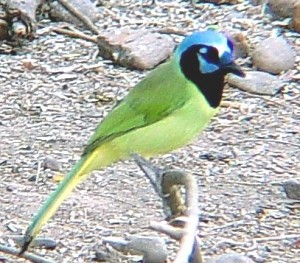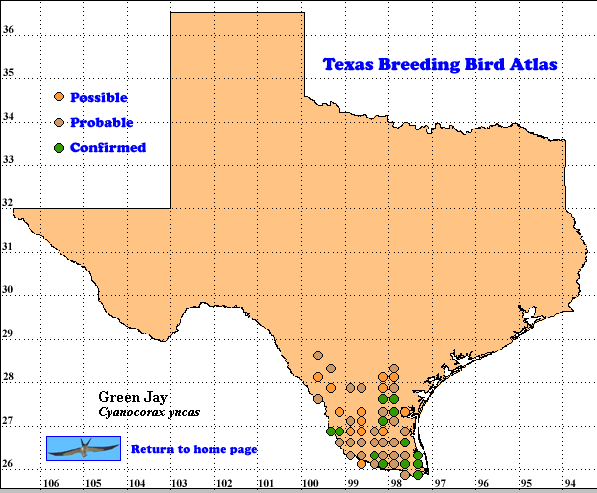The Green Jay, known locally as the Rio Grande Jay, is a brilliantly-colored, tropical species whose range extends into southernmost Texas. The Green Jay population of Central America ranges from west-central Mexico south to the highlands of Guatemala and northern Honduras. The South American population extends from the subtropical regions of Colombia and northern Venezuela south to eastern Ecuador, Peru, and northern Bolivia. The northern population, belonging to the luxuosus group, is believed to be derived from the ancestral yncas group of South America (Gayou 1995, Am. Ornithol. Union 1998).
Its limited distribution in the United States combined with its often boisterous nature and flashy green, yellow, black, and blue plumage make the Green Jay a special treat to visitors of the Rio Grande valley. Birders in South Texas quickly become familiar with the frequent “cheh-cheh-cheh-cheh” calls of the Green Jay along with its dry, throaty rattle, which is similar to those of the Blue Jay (Cyanocitta cristata) and Western Scrub-Jay (Aphelocoma californica; Oberholser 1974).
DISTRIBUTION: In Texas, TBBA data indicated the Green Jay breeds almost exclusively in extreme southern Texas with confirmed records extending north to Kleberg County near Alice and Jim Wells County near Kingsville. The three northernmost records fall south of the 29th parallel and were based on probable evidence. Two of these records occurred in Dimmit County, east and southeast of Carrizo Springs. The third occurred in Bee County, just west of Beeville.
SEASONAL OCCURRENCE: Breeding confirmation of the Green Jay was not easy to accomplish. Of the131 TBBA records, 14% were confirmed, and only two of these were the result of the discovery of eggs or young in the nest.
This resident species breeds from late March to mid-July (Oberholser 1974). Early and late egg dates have been reported by Oberholser as April 2nd and June 29th, respectively. No earlier or later egg dates were recorded by TBBA data; however, a breeding confirmation based on physiological evidence was recorded by Beth Wilson on October 1, 1990 for latilong 27098-F2. A brood patch discovered on this bird suggests a very late nesting date. Bailey (1952) noted that it is often difficult to distinguish the site of an old incubation patch from the unfeathered ventral apterium of an immature passerine during the period between nesting and the fall molt. Whether or not this was the case in this instance is not known. Interestingly, this late record occurred in Jim Wells County, one of the two northernmost records of confirmation.
BREEDING HABITAT. The Green Jay seems to favor areas of dense forest and thick scrub and is usually associated with riparian areas. It is not uncommon, however, to observe this jay in mesquite and other upland habitats, particularly during the summer. The nest is usually well-concealed within dense thickets and trees at a height of 5-7.5 m (17-25 ft). The often bulky cup-shaped nest is constructed of thorny twigs and small stems and may be lined with bits of moss, dry grass, and leaves (Bent 1946). A typical clutch consists of four eggs and occasionally ranges from three to five (Harrison 1979).
STATUS: The status of the Green Jay in Texas seems to be improving. In general, the range as determined by TBBA was similar to the range described by Oberholser (1974). However, a definite northward trend is evident. Oberholser characterizes the northern limit as a line running from Laredo to Falfurrias and Armstrong. He describes the Green Jay as “somewhat irregular along northern limits” and as a “rare winter visitor to Alice and central coast.” TBBA data suggests an extension of the range north of Laredo into Dimmit County and north into Jim Wells and Kleberg counties, as well.
Local checklists also reflect a northward trend. At Lake Corpus Christi State Recreation Area the Green Jay’s status was upgraded from “accidental” in 1976 to “uncommon, permanent resident” in 1988. Similarly, at Falcon State Recreation Area between 1967 and 1977 the Green Jay went from a listing of “uncommon” to one of “resident, seen 75-90% of visits”. However, the Green Jay must still be considered rather uncommon along its northern limits.
The “Birds of Bexar County” checklist considers the Green Jay an accidental species in San Antonio and no record of breeding has been reported there within the last 15 years. Before 1980 there were no reports of the Green Jay north of San Antonio. However, from 1980 to 1984 as many as three Green Jays were confirmed near Keene in Johnson County and nesting was reported there but never verified. It has been suggested that these birds were pushed north by Hurricane Allen that hit the Texas coast in the fall of 1980 (Pulich 1988). By the early 21st century Green Jay was considered common to uncommon’ north to Live Oak, Bee and Maverick counties (Lockwood and Freeman 2004).
Text by Mark L. Fink
Literature cited.
American Ornithologists’ Union. 1998. Checklist of North American birds, 7th ed. Am, Ornithol. Union, Washington, DC.
Bailey, R. E. 1952. The incubation patch of passerine birds. Condor 54: 121-136.
Bent, A. C. 1930. Life histories of North American jays, crews and titmice, Pt.I. U. S. Nat. Mus. Bull.191.
Gayou, D. G. 1995. Green Jay (Cyanocorax yncas). In The birds of North America, No. 187 (A. Poole and F. Gill, eds.). The Birds of North America, Inc., Philadelphia, PA.
Harrison, H. H. 1979. A field guide to western birds’ nests. Houghton Mifflin, Boston, MA.
Lockwood, M. W. and B. Freeman. 2004. The TOS handbook of Texas birds. Texas A&M University Press, College Station.
Oberholser, H. C. 1974. The bird life of Texas. University of Texas Press, Austin. Pulich,
Pulich, W. M. 1988. The birds of northcentral Texas. Texas A&M University Press, College Station.

